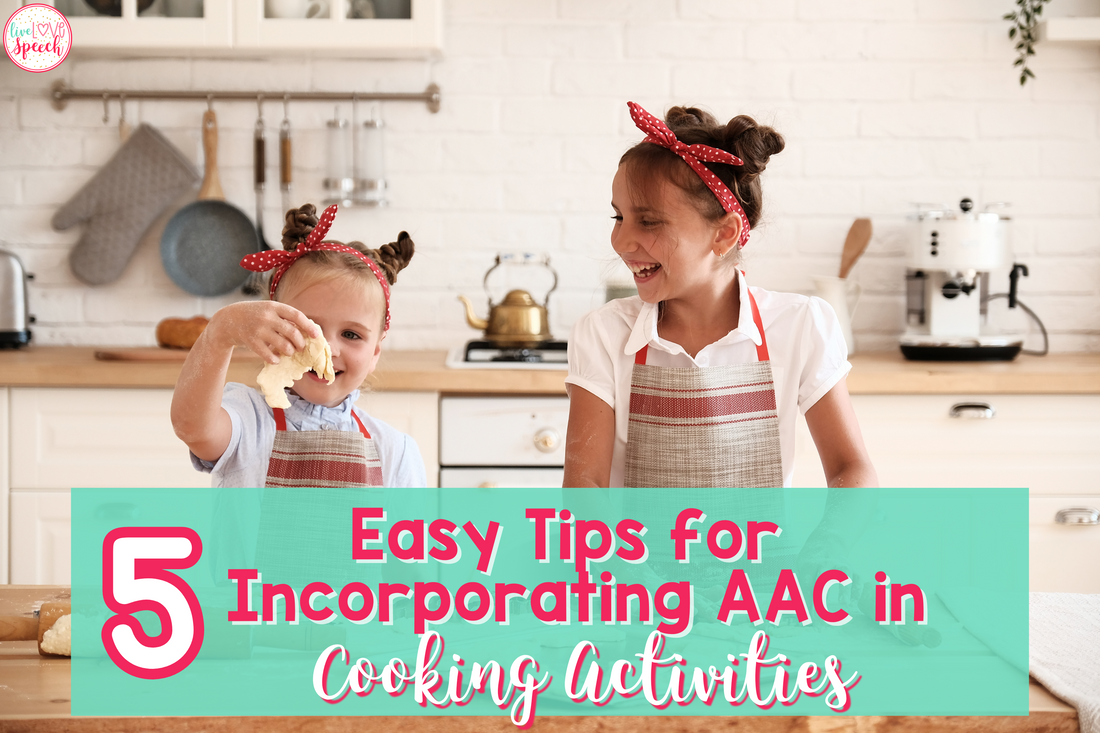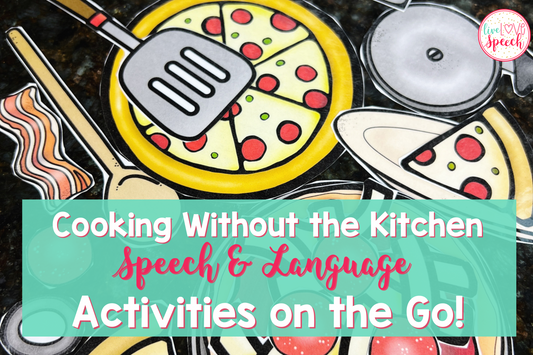
Before stepping into the world of speech-language pathology, terms like AAC seemed like a foreign language to me. Little did I know, AAC stands for Augmentative and Alternative Communication which is a big deal for individuals facing communication challenges. Fast forward to today.... My journey has been able to fine-tune effective ways to incorporate AAC, especially in my cooking-focused activities. Over the years, I've developed tips to create an inclusive teaching environment that seamlessly integrates AAC into cooking activities. As an SLP, my goal is not just to teach communication skills but to make the cooking experience an engaging and inclusive platform for those using AAC.
WHAT IS AAC?
You might already be familiar with AAC if you're an SLP, but for those who aren't, AAC stands for Augmentative and Alternative Communication. It's essentially strategies and tools used to support or substitute speech or writing for individuals struggling with verbal communication. People facing various communication challenges, such as autism, cerebral palsy, Down syndrome, or speech disorders, can benefit from AAC. The methods are diverse, ranging from low-tech options like communication boards, picture symbols, or sign language, to high-tech solutions like speech-generating devices or specialized apps on tablets or computers.
The main aim of AAC is to boost an individual's ability to express themselves, connect with others, and actively engage in daily activities by offering alternative means of communication. What makes it even more impactful is its adaptability, tailored to suit each person's unique needs and abilities. When we consider the potential of AAC in enhancing communication for students facing these challenges, the question arises – why wouldn't we want students who have this inability to effectively learn and thrive with the support of AAC?
Five tips for Effectively Incorporating AAC in Cooking Activities!
1. Customize AAC Systems:
Ensure that students can readily use their AAC devices throughout cooking activities. Take the time to personalize these devices by integrating relevant cooking vocabulary. This involves incorporating essential terms like ingredient names, cooking verbs, and descriptive words such as "hot" or "tasty." By customizing the device to the cooking context, you not only facilitate smoother communication but also empower students to actively participate in the kitchen. This personalization allows them to express preferences, engage in the cooking process more effectively, and ensures that the language support is as rich and varied as the dishes they're creating.

2. Visual Supports:
Enhance your cooking activities by seamlessly incorporating visual supports like picture schedules or step-by-step instructions. These resources can be enriched with images that align perfectly with each stage of the cooking process, providing valuable support for individuals using AAC. Picture schedules offer a clear breakdown of the cooking steps, making it easier for everyone to follow along. Step-by-step instructions, complemented by carefully chosen images, add an extra layer of clarity and understanding to the cooking experience.
For a practical example of how visual recipes can significantly improve the cooking experience, check out my blog post here! Visual recipes, with their combination of step-by-step instructions and vivid images, offer an inclusive learning experience for individuals with communication challenges and benefit learners of all kinds. The incorporation of visual supports transforms the cooking environment into an accessible and engaging space for everyone involved.
3. Model AAC Use:
During the cooking activity, actively demonstrate effective AAC use by incorporating it seamlessly into the process. Utilize the AAC system to label ingredients, ask questions, Utilize the AAC system to label ingredients, ask questions, or express preferences using core words such as 'want,' 'like,' 'more,' 'stop,' and 'help.' By modeling how to navigate and leverage the AAC system in real-time, you provide a tangible example for students. By modeling how to navigate and leverage the AAC system in real-time, you provide a tangible example for students. Labeling ingredients not only enhances vocabulary but also reinforces the connection between words and tangible objects. Encouraging questions through AAC fosters curiosity and engagement, while expressing preferences empowers individuals to communicate their likes and dislikes.
This hands-on modeling approach not only enriches the cooking experience but also creates a supportive environment for students to explore and embrace AAC as an integral part of their communication.
4. Encourage Communication:
Promote communication actively by encouraging the use of AAC in various aspects of the cooking activity. Encourage students to make requests, share preferences or opinions, and provide comments on the cooking process using their AAC systems. Establish an environment where AAC utilization is not just encouraged but praised, fostering a positive atmosphere. Ensure that students feel supported in expressing themselves through AAC by acknowledging and celebrating their efforts. By creating this supportive setting, you not only enhance the communication skills of individuals but also instill confidence, making the cooking experience more enjoyable and inclusive for everyone involved.
Moreover, this emphasis on communication not only contributes to the immediate success of the cooking activity but also carries lasting benefits beyond the kitchen. The skills acquired through AAC usage in cooking can translate into improved communication in various aspects of life, fostering independence and self-expression.

5. Offer Choices:
Encourage active participation by giving students the chance to make choices during cooking activities. Use AAC to inject a touch of enthusiasm, asking questions like, "Do you want chips or pretzels?" or prompting with a cheerful, "What should we add next?" This not only adds an interactive element to the cooking process but also empowers individuals to express their preferences and actively contribute to decision-making.
These choice moments go beyond merely selecting ingredients; they provide individuals the opportunity to showcase their preferences, fostering a sense of ownership and active involvement in the cooking experience. By incorporating decision-making opportunities, you're not just enhancing their cooking skills but also creating a space where individuals can express themselves, connect with the activity, and genuinely enjoy the process.

Visual Support Suggestion
Enhance your AAC experience with my very own Visual Recipe Cards! Featuring 48 kid-friendly recipes, step-by-step visuals, and diverse characters, these cards significantly contribute to supporting communication and language skills. I highly recommend for AAC users, the visuals bridge the gap between words and actions, enabling active participation in cooking activities. Trust me, whether you're an SLP, parent, teacher, or cooking enthusiast, these cards enrich AAC practices by creating an interactive platform for language development. With a wipeable design, they offer practicality for users of all ages and abilities!!
Click Here to Grab Your Visual Recipe Cards!

In exploring how AAC fits into cooking, it's crucial to recognize the profound impact of these strategies, particularly for students who rely on AAC. Seamless incorporation of AAC into cooking goes beyond refining communication skills; it creates an environment where students can express themselves, make choices, and actively engage in shared activities. From customizing AAC systems to encouraging communication and offering choices, these approaches transcend the kitchen, laying the groundwork for improved communication, heightened confidence, and a more inclusive atmosphere in various aspects of life.
So, let's not just cook; let's cook with communication.
SAVE THIS POST
Don't forget to save this post on your favorite Pinterest board so you can come back when you're ready to start cooking!





